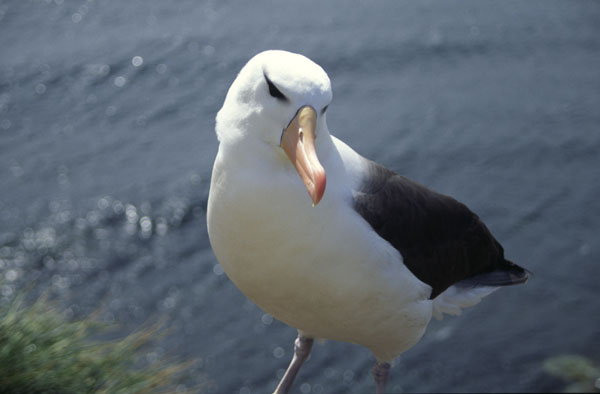
By Ivan Viehoff

Few cyclist tourists have gone to the Falklands. Kay McCallum (see below) could only remember two before me. The countryside is bleak like the Hebrides, a gale blows almost continuously, the roads are few and unpaved, and itís all very expensive. This is a destination for wildlife enthusiasts who want to see penguins, albatrosses, seals, and very strange people. Cycling is a possible way of getting around on the main islands given the absence of public road transport. Things happen slowly, so plan on a fortnight to make it worthwhile. The islands are about the size of Wales, split into East Falkland which is the main inhabited island, West Falkland which is marginally larger, and many small islands. The land outside Stanley and Mount Pleasant Airport Base (MPA) is colloquially referred to as "camp". You need to go in summer (October to March) to see most of the wildlife. These notes are based on a 15 day visit in 1998.
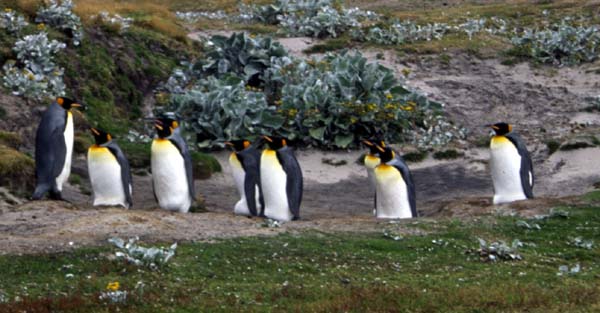
There are about 200 miles of roads on East Falkland and perhaps 80 miles on West Falkland, but it is continuously being extended. It is mostly good gravel, though there are some short paved stretches on the Stanley-MPA road and around Stanley. Some apparently flat roads have frequent drops into steep little valleys. There is also a system of traditional peat tracks. The roadstone in the Falklands is among the hardest in the world and will wear your tyres rapidly. Do your best to keep the grit out of your components, especially between your brake-blocks and your rims, as it can do a lot of damage.
The climate is cool marine temperate (sub-antarctic). Average temperatures are 10C in summer and 7C in winter. Rainfall is usually modest, but sharp showers and hailstorms are frequent. It can snow any time of year, but it rarely settles for long. Daytime wind in summer is typically 35 knots and is predominantly westerly. Imagine spring in the Outer Hebrides. The Falklands are 4 hours behind GMT, same as Chile. Port Stanley and MPA observe daylight saving, but in camp they ignore it. This puts the sun overhead at around 13.00 summer (except in camp) and 12.00 winter, giving daylight hours similar to London.
The OS produce a 1:250,000 map covering the whole islands, though ask the tourist board in Stanley about any new roads. Collect a free minefield map from the mine office in Stanley. Ancient one inch maps, essential for getting off the beaten track, are available very cheaply from the government offices in Stanley, but donít expect them to show the roads. The latest Lonely Planet guide to Chile has an extensive section on the Falklands, previously published in the Argentina volume; a shorter version appears in the Antarctic volume.

In Stanley, you can get B&B from £15 (1997/8). At Kay McCallumís you can camp in the garden to keep the cost down a bit. At interesting spots in camp there is a surprising amount of tourist accommodation from £10 upwards (mainly upwards) - see the brochure at the travel agent or tourist board in Stanley. Some of the information is on the Falkland Islands Tourist Board website. There does not appear to be accommodation for civilians at or near MPA.
The ground is mostly boggy white grass ("soft camp"), diddle-dee shrubland ("hard camp") and bare rock. It is impossible to camp on these. Drained grassy bits suitable for camping are mostly farm homefields, where you will need to ask permission. You need some shelter from the wind, though it often dies down at night. Provided they are not in the business of selling tourist accommodation, a farmer you ask for a camping spot might invite you in.
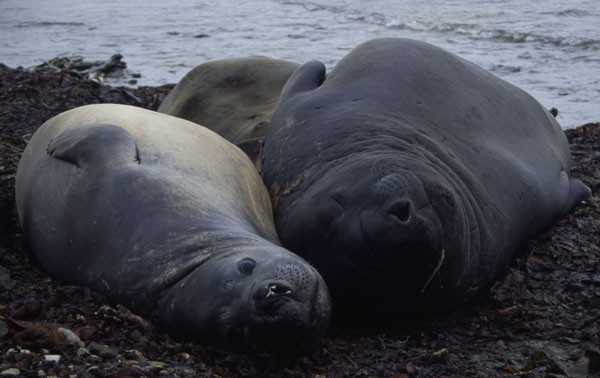
Paraffin, meths, and petrol (leaded) are available in Stanley. Finding fuel for a camp-fire often isnít easy.
The only shops are in Stanley. Some of them are in strange places and unsigned. Some are open Sunday. Farms can always supply mutton, and a few other things in an emergency. Every farmer seems to have a cupboard full of army ration packs. Strange to say, there isn't much surface water available, and the small trickles you occasionally find can be badly polluted by the wildlife, so make sure you are carrying enough with you.
Thereís a sort-of bike shop in Stanley, but donít rely on it.
Take any spare parts you might need. If you intend camping, you need to be confident of your tent and your ability to put it up in a force 10 storm; take a couple of spare pegs and a pole repair. With the windchill and showers, it feels cold practically all the time, so take adequate clothes.
Donít forget your sunblock. With that ozone hole and wind you need it even on overcast days.
Falklands Pounds are used interchangeably with British Pounds. Ascension Island and St Helena Pounds are not accepted. You cannot change Falklands Pounds outside the islands. You can change travellers cheques and cash dollars at reasonable rates in the bank in Stanley, plastic is not accepted. The constant influx of cruise liners means that dollars are accepted in shops, but only at rip-off rates. Itís all very expensive, as almost everything is shipped in from Britain and Chile. Local produce is also expensive, apart from mutton which is very cheap.
The main transport system is Falkland Islands Government Air Service (FIGAS). Theyíll take you where you want to go on the day you want, but they determine the time of the flight - you listen to the radio at 6pm the previous day to find out when you have been scheduled. A 100 mile flight will cost you about £50 single. It is possible to pay to put a bike on a plane provided itís not too full. Although the baggage limit is 14kg, excess baggage charges are only about £0.60/kg. Flights depart from Stanley Airport (5 miles from town) or MPA as you choose. The prospects for getting a hitch are quite good as everyone has 4wds. There are no ferry services between the islands.
You can fly from Brize Norton twice weekly on the RAF troop plane, with a stop at Ascension Island. Up to 25 seats are reserved for fare-paying passengers. Tickets from the Falklands Islands Government Representative in London. They have an Apex fare, single or return, if you book more than a month in advance. You can fly once a week (Saturday) between Punta Arenas in southern Chile and the Falklands on a flight that originates in Santiago. As of October 1999 it stops once a month in Río Gallegos, Argentina (3rd Sat eastbound, 4th Sat westbound). The airline is still LanChile (1999), but is subject to change. If you plan carefully, it is rather cheaper to fly from London to the Falklands via South America than direct. There are Antarctic cruises which start or finish at Stanley, usually going to Punta Arenas. These usually connect with charter flights, as there is not accommodation on the islands for large tour parties.
Arriving at Mount Pleasant Airport
The international airport is MPA, the military base 35 miles from Stanley. It is a matter of surprise to many that British Citizens are treated the same as most foreigners in the Falklands. On arrival, you must show a ticket to leave the Falklands and will be given a visitor permit of up to 4 months. A coach service (£13 single in 1997/8) meets all flights. Only about a quarter of the distance is paved, but the road is gently rolling, a decent surface, and youíll probably have the gale behind you on the way to Stanley. It took me 5 hours to cycle back.
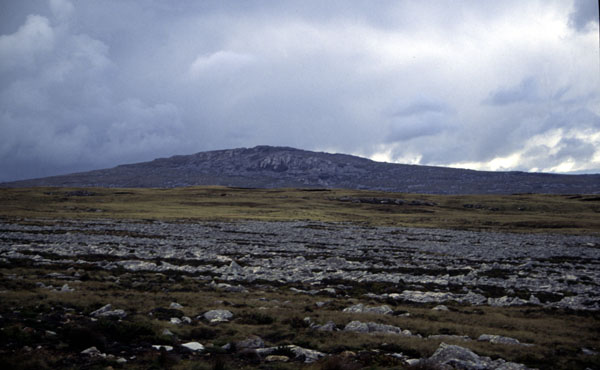
There are basically three dead-end roads: Port San Carlos (70 miles), Goose Green via MPA (90 miles), and Port Louis (24 miles). There is a military road up Mount Kent, but no one saw you go up. The track from Goose Green to San Carlos Settlement (different from Port San Carlos) isnít too bad, allegedly. Magallanic penguins are common and can be seen within walking distance of Stanley. A greater variety of birds can be seen at Berthaís Beach near MPA. Other wildlife sites on East Falkland are mainly difficult to access. It would be an adventure to see if you could get a bicycle up to Volunteer Shanty to see the king penguins, but have a chat to the tourist board to ask how the farmer at Johnsonís Harbour is feeling about visitors. Another ATB/wildlife adventure would be Cape Dolphin, for which there is a signpost near Newhouse of Glamis.
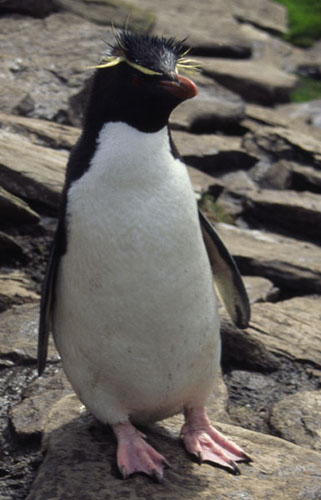
I originally wrote that you will probably be the first cycle tourist to go there. Not any more. My informants tell me at least one intrepid cyclist has now been there. Which just goes to show you can get your bike on those light planes.
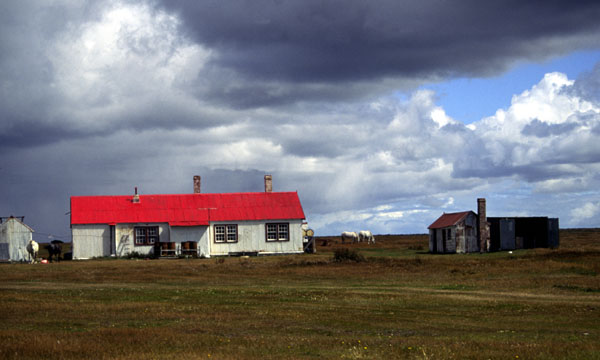
This is a prime wildlife site, and the farmer takes full advantage by charging £22 a night (1997/8) for his simple self-catering lodge, but ask for the free milk and mutton. The best penguin beach (usually all four main Falkland species) is 10 miles up a rough track, which is a reasonable ATB ride. Cheaper to hire theirs than take your own. You have to go on a walk to see albatrosses, elephant seals, cormorants, etc.
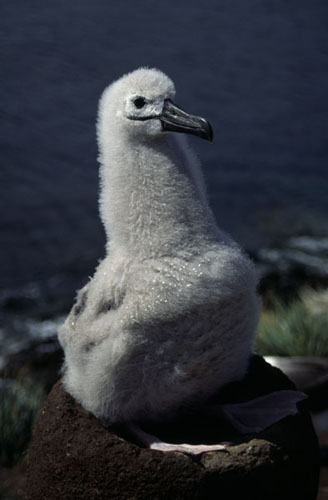
Ivan Viehoff, revised November
2000.
†
